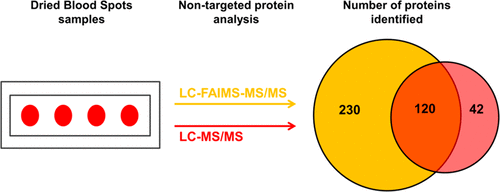当前位置:
X-MOL 学术
›
J. Proteome Res.
›
论文详情
Our official English website, www.x-mol.net, welcomes your
feedback! (Note: you will need to create a separate account there.)
High Field Asymmetric Waveform Ion Mobility Spectrometry in Nontargeted Bottom-up Proteomics of Dried Blood Spots
Journal of Proteome Research ( IF 3.8 ) Pub Date : 2018-05-09 , DOI: 10.1021/acs.jproteome.7b00746 Cecilie Rosting 1 , Jinglei Yu 2 , Helen J. Cooper 2
Journal of Proteome Research ( IF 3.8 ) Pub Date : 2018-05-09 , DOI: 10.1021/acs.jproteome.7b00746 Cecilie Rosting 1 , Jinglei Yu 2 , Helen J. Cooper 2
Affiliation

|
Despite the great potential of dried blood spots (DBS) as a source of endogenous proteins for biomarker discovery, the literature relating to nontargeted bottom-up proteomics of DBS is sparse, primarily due to the inherent complexity and very high dynamic range associated with these samples. Here, we present proof-of-concept results in which we have coupled high field asymmetric waveform ion mobility spectrometry (FAIMS) with liquid chromatography–tandem mass spectrometry (LC–MS/MS) for nontargeted bottom-up proteomics of DBS with the aim of addressing these challenges. We, and others, have previously demonstrated the benefits of FAIMS more generally in proteomics including improved signal-to-noise and extended proteome coverage, and the aim of the current work was to extend those benefits specifically to DBS. The DBS samples were either extracted by the more traditional manual “punch and elute” approach or by an automated liquid surface extraction (LESA) approach prior to trypsin digestion. The resulting samples were analyzed by LC–MS/MS and LC–FAIMS–MS/MS analysis. The results show that the total number of proteins identified increased by ∼50% for the punch and elute samples and ∼45% for the LESA samples in the LC–FAIMS–MS/MS analysis. For both the punch and elute samples and the LESA samples, ∼30% of the total proteins identified were observed in both the LC–MS/MS and the LC–FAIMS–MS/MS data sets, illustrating the complementarity of the approaches. Overall, this work demonstrates the benefits of inclusion of FAIMS for nontargeted proteomics of DBS.
中文翻译:

干血斑非目标自下而上蛋白质组学中的高场非对称波形离子迁移谱
尽管干血斑(DBS)作为生物标志物发现的内源性蛋白质来源具有巨大潜力,但与DBS非靶向自下而上的蛋白质组学有关的文献很少,这主要是由于与这些样品相关的固有复杂性和很高的动态范围。在这里,我们提供了概念验证的结果,其中我们将高场非对称波形离子迁移谱法(FAIMS)与液相色谱-串联质谱法(LC-MS / MS)结合在一起,用于DBS的非目标自下而上蛋白质组学。应对这些挑战。我们和其他人先前已经在蛋白质组学中更广泛地证明了FAIMS的优势,包括改善的信噪比和扩展的蛋白质组覆盖范围,而当前工作的目的是将这些优势专门扩展到DBS。在胰蛋白酶消化之前,可以通过更传统的手动“打孔和洗脱”方法或通过自动液面提取(LESA)方法提取DBS样品。通过LC-MS / MS和LC-FAIMS-MS / MS分析对所得样品进行分析。结果表明,在LC–FAIMS–MS / MS分析中,穿孔和洗脱样品鉴定出的蛋白质总数增加了约50%,LESA样品鉴定出的蛋白质总数增加了约45%。对于冲样和洗脱样品以及LESA样品,在LC-MS / MS和LC-FAIMS-MS / MS数据集中都可观察到约30%的总蛋白,这说明了方法的互补性。总的来说,这项工作证明了将FAIMS纳入DBS非靶向蛋白质组学的好处。
更新日期:2018-05-09
中文翻译:

干血斑非目标自下而上蛋白质组学中的高场非对称波形离子迁移谱
尽管干血斑(DBS)作为生物标志物发现的内源性蛋白质来源具有巨大潜力,但与DBS非靶向自下而上的蛋白质组学有关的文献很少,这主要是由于与这些样品相关的固有复杂性和很高的动态范围。在这里,我们提供了概念验证的结果,其中我们将高场非对称波形离子迁移谱法(FAIMS)与液相色谱-串联质谱法(LC-MS / MS)结合在一起,用于DBS的非目标自下而上蛋白质组学。应对这些挑战。我们和其他人先前已经在蛋白质组学中更广泛地证明了FAIMS的优势,包括改善的信噪比和扩展的蛋白质组覆盖范围,而当前工作的目的是将这些优势专门扩展到DBS。在胰蛋白酶消化之前,可以通过更传统的手动“打孔和洗脱”方法或通过自动液面提取(LESA)方法提取DBS样品。通过LC-MS / MS和LC-FAIMS-MS / MS分析对所得样品进行分析。结果表明,在LC–FAIMS–MS / MS分析中,穿孔和洗脱样品鉴定出的蛋白质总数增加了约50%,LESA样品鉴定出的蛋白质总数增加了约45%。对于冲样和洗脱样品以及LESA样品,在LC-MS / MS和LC-FAIMS-MS / MS数据集中都可观察到约30%的总蛋白,这说明了方法的互补性。总的来说,这项工作证明了将FAIMS纳入DBS非靶向蛋白质组学的好处。









































 京公网安备 11010802027423号
京公网安备 11010802027423号